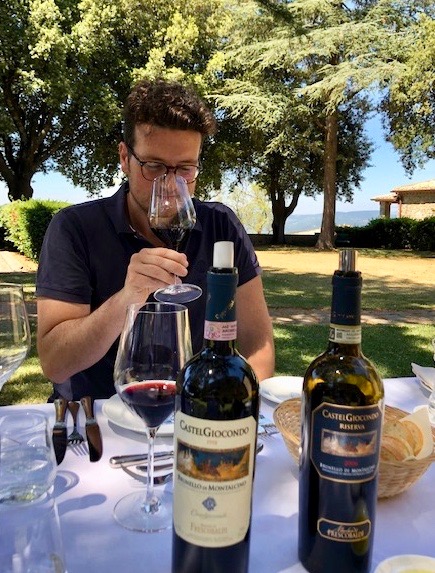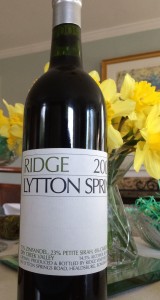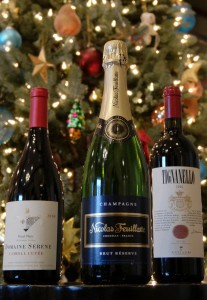If the wine world ever establishes a Hall of Fame, Brunello Di Montalcino will be a charter member! It would share center stage with the planet’s greatest wines such as Bordeaux, Burgundy, Napa Valley cabernet sauvignon and a few others considered to be among the best.
What makes the wine so special? Well first of all, just pronouncing the name can make you thirsty (brew-nell-oh dee mon-towel-chee-no). And that’s good because I can’t think of any better way to slake your thirst than by sipping the silky elegance that is Brunello Di Montalcino. And for me, silky is the word I always associate with the wine.
I know you’re probably thinking that “silky” is a feeling - a texture if you will - and not a taste. But the aroma that precedes the texture and the flavors that follow it are also exceptional too. I’ll get to those other sensory aspects later, but first here is some information on the grape that’s used to make Brunello, and the region where the wine is produced.
Sangiovese is the grape vinified to make the wine. It’s the same varietal and primary grape used to produce most of the reds in Tuscany, including Chianti. Sangiovese can also be a component of “Super Tuscans” which are blends of non-traditional Italian varietals such as cabernet, merlot and syrah. But the sangiovese grown around the small town of Montalcino is considered superior to wines made from the same grape in other parts Tuscany.
And according to the experts, it’s all about the terroir of the vineyards around Montalcino, especially the soil. Terroir (pronounced tare-wah) is defined as the combination of soil, climate and geographic location that determine the quality of a wine appellation. While the climate and the geographic location of vineyards in the Montalcino appellation are ideal for producing excellent Brunello, the varied soils of the region are given most of the credit for the exceptional quality of the wine.

On a visit to Brunello producer Castelgiocondo last month, their wine maker Filippo Manni took me to an area where several feet of exposed vineyard showed limestone, clay, schist, and volcanic soils stacked on top of each other. He said the complexity of the soils is the major reason for the superior quality of the sangiovese produced in the Montalcino region.
So what should you expect when you put that glass of Brunello to your lips for the first sip? The aroma of Brunello can be varied, but I usually get dark fruit, spice and sometimes leather. And like most other quality red wines, Brunello produced in a good to exceptional vintage will have two flavor profiles. The first, when the wine is under 10 years old, will have dried cheery or cranberry flavors along with fairly noticeable tannins and bright acidity. As the wine matures, the flavors get richer with caramel nuances to the fruit while the tannins and acid soften. And here’s where you’ll begin to feel the silkiness of the wine.
Castelgiocondo is one of several wineries owned by the renowned Italian wine family, Frescobaldi. After visiting the winery, cellars and vineyards of Castelgiocondo, my wife and I sat down for an elegant outdoor lunch with winemaker Manni. We tasted through the winery’s entire portfolio, including three Brunello’s, a Rosso di Montalcino (Carpo Al Sassi) and a merlot (Lamaione).
We enjoyed each of the wines, but the 1998 Castelgiocondo was everything I love about Brunello. The aroma was redolent of tea and leather and the flavor of dark cherries with nuances of caramel and herbs went on and on. Of course, the texture was pure silk.
Brunello is not inexpensive. Expect to pay anywhere from $50 to $150 a bottle. You might wish to start out by trying a bottle of Rosso Di Montalcino. Rosso, which is produced from young vines or wines that do not meet the strict standards of a winery, are usually priced between $25 and $50 a bottle. These “Baby Brunello’s” can be delicious wines too, and can give you a tasty hint of what to expect once you trade up.
While Brunello Di Montalcino is usually very good in just about any year, here are vintages that are rated among the best in the past two decades: 2001, 2004, 2006, 2007, 2010, 2012 and 2015.
Enjoy!
What makes the wine so special? Well first of all, just pronouncing the name can make you thirsty (brew-nell-oh dee mon-towel-chee-no). And that’s good because I can’t think of any better way to slake your thirst than by sipping the silky elegance that is Brunello Di Montalcino. And for me, silky is the word I always associate with the wine.
I know you’re probably thinking that “silky” is a feeling - a texture if you will - and not a taste. But the aroma that precedes the texture and the flavors that follow it are also exceptional too. I’ll get to those other sensory aspects later, but first here is some information on the grape that’s used to make Brunello, and the region where the wine is produced.
Sangiovese is the grape vinified to make the wine. It’s the same varietal and primary grape used to produce most of the reds in Tuscany, including Chianti. Sangiovese can also be a component of “Super Tuscans” which are blends of non-traditional Italian varietals such as cabernet, merlot and syrah. But the sangiovese grown around the small town of Montalcino is considered superior to wines made from the same grape in other parts Tuscany.
And according to the experts, it’s all about the terroir of the vineyards around Montalcino, especially the soil. Terroir (pronounced tare-wah) is defined as the combination of soil, climate and geographic location that determine the quality of a wine appellation. While the climate and the geographic location of vineyards in the Montalcino appellation are ideal for producing excellent Brunello, the varied soils of the region are given most of the credit for the exceptional quality of the wine.

On a visit to Brunello producer Castelgiocondo last month, their wine maker Filippo Manni took me to an area where several feet of exposed vineyard showed limestone, clay, schist, and volcanic soils stacked on top of each other. He said the complexity of the soils is the major reason for the superior quality of the sangiovese produced in the Montalcino region.
So what should you expect when you put that glass of Brunello to your lips for the first sip? The aroma of Brunello can be varied, but I usually get dark fruit, spice and sometimes leather. And like most other quality red wines, Brunello produced in a good to exceptional vintage will have two flavor profiles. The first, when the wine is under 10 years old, will have dried cheery or cranberry flavors along with fairly noticeable tannins and bright acidity. As the wine matures, the flavors get richer with caramel nuances to the fruit while the tannins and acid soften. And here’s where you’ll begin to feel the silkiness of the wine.
Castelgiocondo is one of several wineries owned by the renowned Italian wine family, Frescobaldi. After visiting the winery, cellars and vineyards of Castelgiocondo, my wife and I sat down for an elegant outdoor lunch with winemaker Manni. We tasted through the winery’s entire portfolio, including three Brunello’s, a Rosso di Montalcino (Carpo Al Sassi) and a merlot (Lamaione).
We enjoyed each of the wines, but the 1998 Castelgiocondo was everything I love about Brunello. The aroma was redolent of tea and leather and the flavor of dark cherries with nuances of caramel and herbs went on and on. Of course, the texture was pure silk.
Brunello is not inexpensive. Expect to pay anywhere from $50 to $150 a bottle. You might wish to start out by trying a bottle of Rosso Di Montalcino. Rosso, which is produced from young vines or wines that do not meet the strict standards of a winery, are usually priced between $25 and $50 a bottle. These “Baby Brunello’s” can be delicious wines too, and can give you a tasty hint of what to expect once you trade up.
While Brunello Di Montalcino is usually very good in just about any year, here are vintages that are rated among the best in the past two decades: 2001, 2004, 2006, 2007, 2010, 2012 and 2015.
Enjoy!




